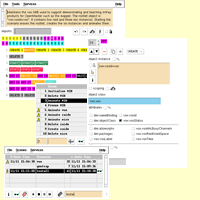Simulator

|
 Click to enlarge Click to enlarge
|
- can emulate network elements or act on real systems,
- can be seen as an object manager or as a command processor,
- provides network actions for creating, deleting and setting instances (M-CREATE, M-DELETE, M-SET),
- can retrieve particular instances (M-GET) and pass the returned attributes to other actions,
- can also send any kind of actions (M-ACTION), events (M-EVENT) or SNMP traps,
- combines actions into scenes where individual actions are run one after the other,
- groups related scenes into individual scenarios saved in separate text files,
- includes processing actions which, in a scene, can start and stop other scenes, add delays between actions, break its normal sequential flow with IF and GOTO statements, make it loop, pass context values between actions, run any SML code and even communicate with other applications using the broker,
- consists of three applications: the demon, the runner and the editor,
- the demon runs simulations in the background,
- it can run several scenarios and several concurrent scenes in the same scenario at the same time,
- the runner dialogs with the demon to display the scenarios which are currently loaded, their description and their running and trace conditions,
- it can load and unload scenarios, start and stop them, run individual scenes,
- the editor takes care of building scenarios, scenes and actions,
- scenes in a scenario are presented as a storyboard with different colors for each type of action,
- operations on the MIB, actions and notifications or traps are entered through dedicated inspectors which are automatically generated from GDMO and RFC definitions.

